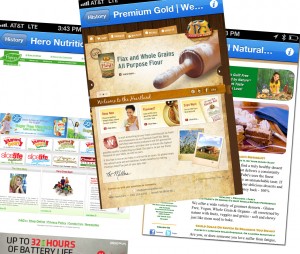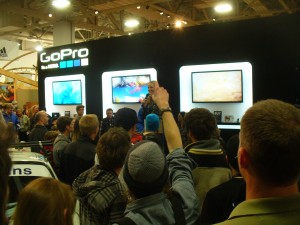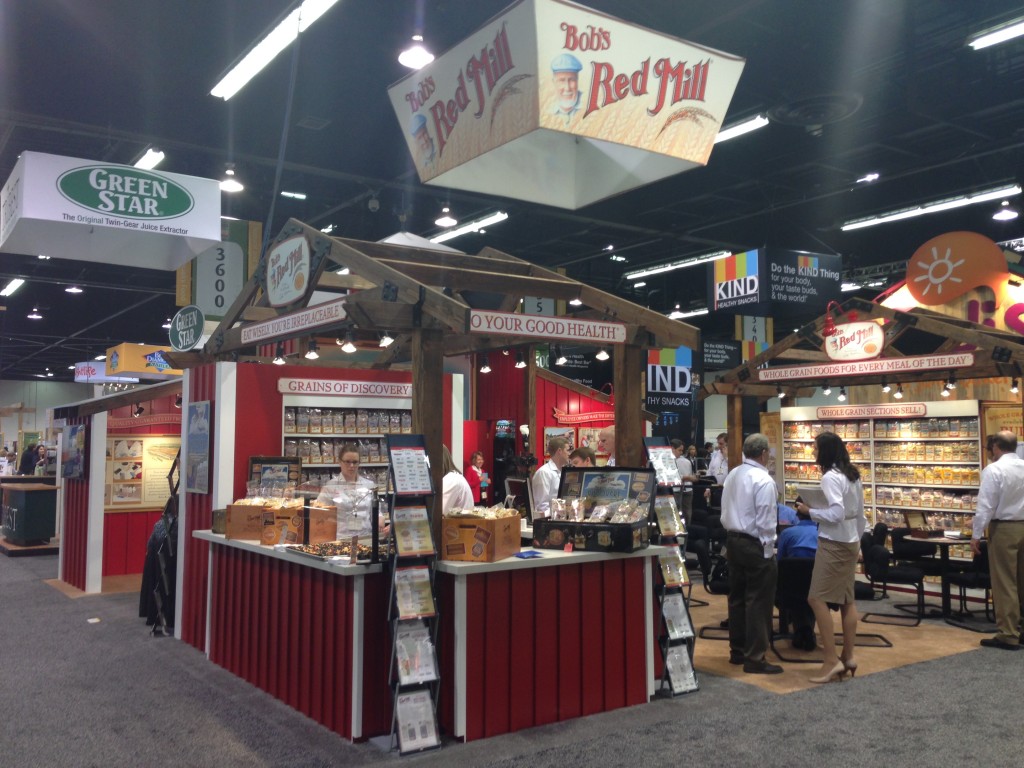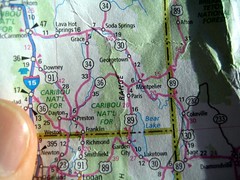Social Media Metrics Webinar (replay)
Here’s the Social Media Metrics Webinar that Roger Pike and I did last month. A few people were curious to watch it again, or had to leave early.
Hey, that’s what the blog is for! Enjoy:
[tube]U8nX37XqsRA[/tube]
Here’s the Social Media Metrics Webinar that Roger Pike and I did last month. A few people were curious to watch it again, or had to leave early.
Hey, that’s what the blog is for! Enjoy:
[tube]U8nX37XqsRA[/tube]
Are QR codes even worth using anymore?
I admit it. I carry a cell phone around with me that can read QR codes in an instant. Yeah, it’s the new iPhone 5. Works a whole a better than my last phone, the iPhone 3, which was my last phone.

Nonetheless, I scan QR codes all the time. Why? Because I want to see if they work. And, it appears that many of them fail miserably.
Most QR codes miss at least one of the three main items that are required for a successful QR code. One, they have to be easy to scan. Two, there has to be an explicit stated reason to scan the QR code. And three, the link that you are taken to must be easy to read and optimized for a smart phone, since most QR codes are scanned on a smart phone.
When I was at Expo West in Anaheim in March of this year, I scanned about 15 QR codes. Not one of them had all three of those items in place. Most had the first two, but failed on the third – which is the optimization of the landing page for the QR code.
I’ve seen a number of articles in the past few months that lament QR codes, and some even go so far to say that QR codes are dead. I don’t think QR codes are dead, but I do think that they are not used quite as much as they used to be. Just a couple of short years ago they seem to be ‘the new thing’ but it never quite materialized in that way. Instead, QR codes are more effective when used for a very specific purpose such as downloading a sell sheet at a tradeshow, or linking to a specific landing page for more information then you can easily show.
However, it still comes down to this small but apparently difficult challenge: getting all of the elements of your QR code right before launching it. First, make sure people know exactly what they get when they scan the code. Describe what it is they’re going to get when they scan it. Is it more information? Is it a contest they can enter? Is it some downloadable PDF file that gives them more information? Is it a white paper?
Next, make sure the QR code is easy to scan. Black ink on a white background on a fat surface is best. It should be at least an inch to an inch and a half in size. If you really want to make a big deal every cougar out of your QR code make it a foot in size and invite people to scan it. Put it in their face.
Third, create a landing page that looks great on a smart phone. A typical webpage comes up on a typical smart phone with such small font and graphics that it is useless and people will just go away.
Finally, test it! Print out your QR code in real size, scan it with several smart phones in your company, examine the results and make sure it all works.
No, I don’t think QR codes are dead. But it appears that most companies attempting to use them are slowly killing them by misuse.
Proud to be associated with the good folks at Classic Exhibits:
[tube]http://vimeo.com/64742070[/tube]
Check out our Exhibit Design Search here…
I first encountered GoPro at the 2009 Outdoor Retailer Winter Market show in Salt Lake City. Nick Woodman was making a spectacle of himself. About once an hour, he would get on top of a platform and start yelling at the top of his lungs. He would exhort visitors to check out the brand-new product – a small HD camera that captured crazy video with a wideangle lens. It was small enough to strap to a helmet, chest, end of a ski pole, wherever.

During these hourly exhortation’s Nick would regale his audience with examples of how great his product, the GoPro camera – and how it captures extreme sports videos – is. It also engaged eager visitors with the chance of winning one.
The story of GoPro is one that happened very quickly. It didn’t take long for the combination of trade shows, social media, and virtually giving away the store every single day to create a rabid following.
If you follow GoPro on Facebook, you’ll notice that they give away everything they make to one person every single day. I’ve signed up hundreds of times and never won. But it doesn’t keep me from signing up again and again and again. That’s how much I’d like to get my hands on their latest and great HD sports-action toy.
Early in 2013, Nick Woodman, the CEO and main figurehead of GoPro was featured on the cover of Inc. magazine. The story was about how he had grown the company to a multi-million dollar enterprise and created a new camera niche virtually out of nothing. The company had done it with a great product that is groundbreaking, and the combination of tradeshow marketing, social media and pure moxie.
Since I saw them at the 2009 outdoor retailer when a market in salt Lake city, I’ve been a big fan of GoPro. They offered $100 off of a camera if you purchased at that time and a coupon for discount on a future purchase when their new HD camera came out. I bought one of their early cameras and have had fun with it ever since.
In January 2013 I attended Outdoor Retailer Winter Market and it didn’t take me long to find the GoPro trade show booth. It wasn’t large compared to many other booths at the show, about 30 x 30, but it was plastered with a dozen or so large screen video monitors. As you enter the booth you were given a chance to sign up and possibly win a new HD camera. They also indicated that with the sign up, you would be emailed a coupon for a $100 discount on their new HD camera. So in effect, they’re giving you a chance to win something and they’re capturing your information so they can stay in contact with you.
I talked to one of the girls working the booth and discovered that Nick was not there, but it didn’t matter by this point because the company was too big for Nick to go to every tradeshow. GoPro has quickly proven itself to be a serious player in the camera industry, and has been called ‘the fastest growing company in the world.’
Several times a day a GoPro booth staffer stands up to give away T-shirts, swag and of course that coveted GoPro HD model camera. Hundreds of people yelled, screamed, waved arms and otherwise made fools of themselves hoping their name would get called.
Go Pro’s custom tradeshow booth matched their brand’s look, feel and style. It looked a bit brash and with the multiple video screens your eyes were drawn to action, action, action as the sports action videos played in an endless loop.
Suffice it to say that with the combination of savvy social media, aggressive trade show marketing and a groundbreaking product, GoPro dominates their niche. They certainly have new competitors – with any new product that carves out a big share of the market, someone will come in and try to catch to the leader. And someone may yet catch up with GoPro. But GoPro’s excellent marketing – including tradeshow marketing – is proving to be all they need right now to be the leader of the pack.
Then check out the selection of videos.
(Warning: self-promotional blog post. Not recommended more than once or twice a year…)
It was my 11th year at Expo West as a representative of a company that provides exhibit booths for exhibitors.
First: 11 years? Kidding, right?

No. The first booth client I had way back in 2003 was Kettle Foods of Salem, Oregon, which lead to doing a booth for Nancy’s Yogurt / Springfield Dairy, Natracare, Hyland’s Homeopathic, gDiapers and many others.
Besides having to basically eat your way through the day with the glut of food samples, I spent time meeting exhibitors and making connections.
And making sure that my new projects were working.
The two new booths my company, Communication One Exhibits had this year were from Bob’s Red Mill and gDiapers. The Bob’s Red Mill was a custom 30’ x 30’ booth, designed by Greg Garrett Designs of Vancouver and fabricated by Classic Exhibits. It was a stunner and was definitely well-received by the company – including Bob Moore, who called it ‘impressive’ – and show visitors. The exhibit had three structures – a main company info-display area, a product display area and – in a new move for Bob’s Red Mill – a food sampling station. The main structure was capped with a 4’ cupola high atop a structure that echoed their mill store in Milwaukie, Oregon. Either end of the main structure had 52” video screens that continuously showed informative videos.
Bob has a great way of making an entrance. Bring along a Dixieland band! Check out the video from Day One:
httpv://www.youtube.com/watch?v=t8aFhxjan0w

The other booth was at the other end of the scale. gDiapers, of Portland, Oregon, is a company that offers reusable diaper covers with disposable inserts. Years ago, when I was VP of Sales and Marketing for Interpretive Exhibits, we designed and constructed a 20’ in-line booth for gDiapers that had plenty of display space, slat wall and a fabric banner across the top. As their clientele needs evolved, so did the company’s desire for a simpler display that was easier to set up. So with the help of Portland’s Boothster, we designed and built a 10’ inline booth that had a small display area and a large 10’ fabric back wall, along with cardboard chairs and cardboard tube-constructed counter with wrap-around graphic. The booth looked great and gDiapers loved it!
Yes, I blog about social media and tradeshow and event marketing, but my company Communication One Exhibits has a ton of great capabilities to design and fabricate tradeshow booths to suit any need.
Let me now step off of my soapbox…thank you verry much for your time!
See previous posts in this series: Basics, Look at What Others are Doing, Don’t Publish Selfish Content, Don’t Just Push Stuff Out, Build Relationships, Try New Things and Create a Roadmap.
Since social media is always on 24/7/365, it’s easy to sleep through something important. No, that doesn’t mean you have to stay awake and never hit the sack, but it does mean that you need to be aware that when something breaks, immediate action is called for, even if that immediate action is to send out a tweet or post to Facebook when you’re still sucking down your first cup of coffee waiting for the caffeine to kick in.
For instance, if your company is mentioned in a negative way, such as a product complaint or customer service issues that is wacky or unusual enough that it might go viral (see United Breaks Guitars), you can’t wait to respond. You have to craft a message of some sort right now. That may mean the only message you get out before management gets a chance to weigh in is ‘we see the issue and will have a response soon.’

Those who wait allow the energy of social media to potentially grow exponentially. But if you get out in front of the issue, you at least are telling the world that you see there’s an issue and will make your statement soon. Then you put together your statement and get it out there.
Social media is happenin’ NOW and there’s nothing you can do to hold back the tide once it gets going.
When you prepare for a worst-case scenario, it doesn’t mean that you’ll ever have to use that response. But it does mean that IF such a negative thing happens, you at least have a framework of a plan in place on how to respond.
On the other hand, good things can happen in an instant as well. Oreo Cookies had a social media team in place while watching the Super Bowl last month. When the power went out for 35 minutes, Oreo had an ad posted before the power came back up. The story of the quick response is well documented by David Meerman Scott on his fine WebInkNow.com blog.
You can generate good things in an instant, and you can get in front of bad things quickly. But you must be prepared to react or act instantly, and not wait for some corporate approval. By then it’s probably too late.
Ignoring negative comments on your blog or Facebook page is not a good practice, either. If you can’t at least acknowledge the comment to say thanks for sharing your thoughts, it opens the door to a chance that the comments will feed the internet beast, drawing more negative comments which then becomes like a snowball rolling down a hill, gathering mass and speed. Instead, offer a thanks to the commenter and address the comment if possible (snarky name-calling need not be responded to unless there’s a legitimate concern being expressed; even then, point out that you’re happy to respond to negative comments but that name-calling is not okay). Use negative comments as an opportunity to learn what’s bugging your community. Is there a problem you’re not seeing? Are you missing a negative situation that could lead to worse problems? Often, those negative comments are an opening to seeing things that you might have otherwise missed.
Think Long Term: remember that those comments and videos and blog posts and Facebook comments and tweets are there for a long time. Like, as long as the internet will exist. In other words, longer than we’ll be around. Damaging comments and posts can and will stick around for a long time, doing their damage long after we’re gone. By keeping this thought in mind, it’ll help filter everything through a screen which allows you to post only those items which you don’t mind sticking around for decades to come.
And how’s your online reputation? One of the fastest growing enterprise opportunities in the online world is Reputation Management. It’s the new social media skill. How are you at managing your online reputation? Can you suss out the bits and pieces that will shred your reputation? Can you point out the great posts and tweets that build up yoru reputation? By all means, take time to look closely and see what is really going on regarding you – and the company you work for. Make note of anything that may not look or feel right, and work to correct it. You’ll be glad you did. And be sure to download our Social Media Audit outline to help you get started.
To recap:
See previous posts in this series: Basics, Look at What Others are Doing, Don’t Publish Selfish Content, Don’t Just Push Stuff Out, Build Relationships and Try New Things.
Now that you’ve worked your way up through the basics (social media audit, social media policy, listening) and have been exposed to the various elements of social media/tradeshow promotion, you’re ready to create a playbook.

This roadmap will take you through each show throughout the year. My suggestion is to create a playbook for each show that you go to, although if you do several similar small shows, you can probably create one plan and work it for each of those shows. For the bigger shows, though, you should create an individual calendar.
First, settle on your realistic goals. Determine what you did last year in terms of leads, press mentions, sales, etc., and then set this year’s goals in each area.
Identify your point person for the effort. Often this is one person who leads a small support staff.
Identify content you want to create, and how you’re going to create it. This can range from blog posts, to videos (testimonials, client interviews, guest interviews, demos, etc.), photographs and more. Identify who’s going to create and curate the content.
Identify any promotions you are implementing that are show-specific. These could focus on new product releases, special show deals and more.
Integrate your social media efforts with the rest of your marketing efforts. Too often, companies fail to successfully create a synergy with the social media marketing and the traditional marketing efforts such as radio or TV, print and direct mail. By getting these two areas together (if they aren’t already), you can create a monster promotion that is more than the sum of the two parts.
Finally, create your calendar. A good calendar will start a year before the show, and will include any post-show efforts of content release from this year’s show. About six months before next show, you’ll want to meet and brainstorm ideas for using social media to bring people to your booth. Then set the various tasks at 3 months, 2 months, a month and the weeks leading up to the show. This might be something such as searching for the show’s hashtag to check activity or contacting any promotion partners to start implementing the various tasks that complement each other. Toss any ideas into your calendar – chances are you can’t overdo what the calendar tells you to do. Make notes as you go along and use those to adjust and make course corrections for the next show.
Now that you’ve created your playbook with promotion, content ideas and tasks, just execute the plays as they come up.
Recapping…

See previous posts in this series: Basics, Look at What Others are Doing, Don’t Publish Selfish Content, Don’t Just Push Stuff Out and Build Relationships.
Yes, you MUST try new things. One of the coolest ‘experiments’ I’ve run across for pre-show marketing was done by Griffin Technologies of Nashville (described here on the Classic Exhibits blog).
In a nutshell, Griffin refurbished a VW camper van, set up a website to dump a bunch of fun content on, then headed off to the Consumer Electronics Show in Vegas, all while continuing to blog and post videos to the blog. By the time they arrived at the show, hundreds of people were waiting for them – as successful a pre-show marketing experiment as I’ve seen in ages.
So, yes, you must try new things. Experiment. Remember that what worked last year may not this year. This goes back to those idea that you may adapt or copy that we discussed in an earlier segment of this series.

Ask yourself – what do my customers want? Is there any way to use that knowledge to crate a buzz? Do your products or services have an element that you can exploit that other companies can’t? What can you use to get their attention?
Don’t be afraid to try a new angle on an old promotion. Put a twist on another company’s successful social media promotion. Experiment, experiment, experiment!
How can you get their attention? By looking at how others have succeeded at getting attention gives you a clue to how you can try to get attention as well. Don’t be afraid to take a chance on a promotion, whether it’s old or new. If it feels like it fits your product, service and company, it’s probably worth a shot.
Recap:

See previous posts in this series: Basics, Look at What Others are Doing, Don’t Publish Selfish Content and Don’t Just Push Stuff Out.
What? Social media ain’t for building relationships! Those so-called conversations are just a tweet or two or maybe three and then nothing! How can you build a relationship on that?
First, let’s define relationship in terms of what it means in social media. Here’s what it is NOT: a date, a lover, your mother, your best friend or a co-worked. Those are all relationships that are done face-to-face. And they’re all different.
Creating a relationship with someone online is different. It’s about finding someone that is like-minded in at least a few ways and supporting them in their endeavors. Beyond that, your online social media relationships can be spread far and wide. You may be able to connect with the CEO of a Fortune 500 company or your favorite rock star. Okay, that’s not a real relationship, but consider that you may be able to make a valuable connection with some one that’s higher up in a company that can open doors for you.
So, to keep these online relationships on the positive side, here are the things to remember.
Honesty is still the best policy. You may not be a 75-year old guy in a trailer impersonating a 22-year old model, but there are levels of deception that some people still feel are okay. I disagree. There’s no level that’s acceptable. If you represent yourself as someone you’re not, it will eventually catch up to you.

Be authentic. Slightly different than honesty, authenticity has to do with sharing thoughts online that you truly believe and support. Are you being true to your vision with your postings, or are you just being irreverent, short-sighted and snarky at times?
Be real to create trust. Now that you’ve committed to being honest and authentic, this ‘real-ness’ leads to building trust. The acts that build trust over time contribute to your overall online reputation, which helps you build your business.
Advocates are an incredible asset, so pay attention and nurture them. In the social media world, an advocate is someone who will stand up and defend your company and your products, and go to great lengths to stand in on your behalf in situations where you would otherwise have to go on the offensive to clear up misinformation or deal with a situation that could create negative press. When you identify a true advocate, do a little research and find out who they are (easy to do if they’re on Facebook or Twitter), and if appropriate, gift ‘em now and then, so they’ll continue to be an asset.
Really connect. When you find someone online that resonates with you in some noticeable way, reach out to him or her. Look up their business. Pick up the phone. Send a personal email. I’ve made terrific friends a few times by just picking up the phone. It helps put a personality to the online presence, and next time you’re in their city, make a point of trying to schedule a lunch or coffee. You’ll be glad you did.
Recapping:

photo credit: Josh Jensen
See previous posts in this series: Basics, Look at What Others are Doing, and Don’t Publish Selfish Content
I recently was invited by an unnamed exhibit company to ‘like’ them on Facebook and follow them on Twitter. So I went to check out their social media sites and see what kinds of things they were up to.
Hate to say it, but I was pretty disappointed. The Facebook page was just self-promotional regurgitations and the Twitter account echoed the Facebook page. The posts were simply ‘New Catalog!’ or ‘Special Promotion’ or ‘ Which sign is right for you?’
The first rule of social media engagement is ‘don’t just push stuff out.’ Take time to do the following, in an intentional manner:
Listen: know what’s going on in your industry. Follow other companies and bloggers that are active and knowledgeable. See how they interact with their audience. Read what kinds of topics they’re posting about and what the reaction is from their readers. Track keywords using Google Alerts, so you’re getting notified in real time about what’s going on. Even if you did nothing else, the simple act of listening to your industry using social media will undoubtedly be quite an education.
Engage: once you have listened for a while, you’ll see what types of questions are being asked and what topics are important to your industry. Jump in and make comments and ask questions of your own.
Respond: when your followers make comments, don’t just let them sit there. Ignoring comments, especially negative comments, is bad form and bad practice. Take some time to respond with a thoughtful comment or question of your own. Make it a conversation. Yes, some online conversations are very short – in fact, most are – but they’re still valuable because you’re showing the other person that you care enough to respond.
Measure: as your engagement builds over time, take some time on a regular basis to measure a few things. Facebook is great for measurement. On your company page, you can look at your page insights and get revealing demographic information about who is responding, listening and who’s talking about those various topics. Twitter does not offer nearly as much information, but you do have the ability to count re-tweets, which is a great measure of the value of that particular post. You can also track Twitter followers and trends. By using Google Analytics, you can see how much traffic Twitter drives to your blog or website.
Help! Yes, you can offer help to those in your industry. Whenever the opportunity comes up, offer suggestions, answer questions, and be a resource. If you do this with the mindset that you’re not trying to just create a sale, but to position yourself as a knowledgeable leader, it will help you in the long run and lead to good things.
Be intentional and consistent: when it comes to intention, a lot of us have good intentions. But unfortunately good intentions don’t always mean good outcomes. So when you think about intention when it comes to social media, start with the idea that you’re going to focus on just a few things: don’t get distracted by pet photos, goofy videos or hot links. Instead, be there with the intent to uncover what people in your industry are talking about, what’s bugging them, and how you might help. Consistency is important, too, as it puts you in the mix on a regular basis. Consistency is NOT spending an hour today and an hour next Monday and another hour on your company’s social media because no one else is doing it. No, consistency is making sure that you, or someone in your company is tasked to show up and listen, learn, engage and respond on a regular basis, hopefully at least once or twice day, even if only for ten minutes at a time. Regularity, consistency and focused intention will put you in front of 90% of your competitors.

Collaborate: so you want more content for your blog? Or you want something to chat about on Twitter? Or you need photos for Facebook or video for YouTube? Contact one of your social media followers that pique your interest and work out a mini-deal: you’ll help them out if they help you out. Interview someone. Exchange blog posts. Working together not only helps create more content more quickly, it fosters relationship-building, which spreads your name and your company’s name throughout cyberspace in a positive way.
To recap:

photo credit: ▓▒░ TORLEY ░▒▓